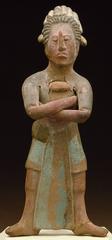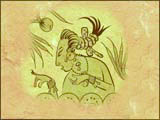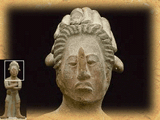
 |
This figure can be identified as a dignitary by his proud, dignified bearing. He stands with his arms crossed and legs spread apart, assuming a pose of power and influence. He is dressed in a wide belt and long apron, a CEREMONIAL garment originated by the Mayas' predecessors. Although sparse, his costume includes a PLAITED hairdo and headdress that also identify him as a man of importance.
The head and face were modeled with great care, whereas the body was treated more simply. This compact figure was made to be viewed from the front, with both sides of the body equally distributed to either side of center. This SYMMETRY creates a stable, balanced form, which suits the image of power portrayed. People rotating or in movement with full gestures are also common. These figurines emphasize human qualities that are usually absent in other forms of Mayan art.
|
|
The fine, expressive face of the dignitary is quite NATURALISTIC. The man has the broad, flat forehead and distinctive nose typical of the Maya. To achieve this facial type, the Maya practiced a custom of deforming the skull by binding the heads of infants before they were one week old. They placed two smooth, tightly bound boards on the forehead and back, forcing the head to grow upward and changing its contour from round to long. |
 |
This resulted in a continuous line from the top of the head to the tip of the nose, interrupted only by the characteristic high bridge of the Mayan nose. For further emphasis, both men and women of high status wore long hair in elaborate styles and headdresses in the shape of animal heads, birds, or flowers. Sprays of precious feathers were also added for decorative effect. |

Key ideas.
Where does it come from?
What does it look like?
How was it used?
How was it made?
How big is it?
Who Knows?
Additional resources.

